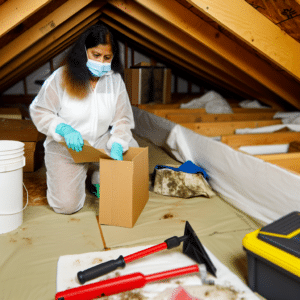
Being a property owner is a great feeling. Waking up in the morning and enjoying that first cup of coffee in your own kitchen is one of the simple joys of life. Walking toward your business, unlocking the front door, and greeting the new workday can fill you with pride. Along with those great feelings, home and business owners may experience pangs of anxiety associated with thoughts of destructive elements like floods.
When floodwaters invade homes and businesses, they damage the contents inside. If these waters are not removed in an effective and timely manner they may ruin the structure and integrity of the property. While both of those factors may be common knowledge, there is one important aspect of floodwaters that property owners may not be aware of: these waters can also be hazardous to their health.
Along with damaging the property, floodwaters may also cause harm to the home or businesses residents and occupants. Floodwaters may contain a variety of harmful elements they’ve picked up on their way to invading the property. These floodwaters could contain harmful elements such as contaminants, bacteria, pesticides, insecticides, parasites, dead animals, microorganisms, and raw sewage.
Before you enter a flooded basement or office to save valuables or assess the damage, it’s best to identify which type of floodwater has damaged your property. The Institute of Inspection Cleaning and Restoration Certification (IICRC) classifies floodwaters into three distinct categories: Clean or Clear, Gray and Black.
Below, we’ll define each of these floodwater types and explain which health risks they may present.
Clear or Clean Water
Clear or clean water poses the least amount of health risks to residents and occupants. As its name suggests, this type of floodwater is clear and contains very few contaminants. This is due to the fact that these floods are typically caused by water sources such as overflowing toilet bowls, melting snow or ice, or a burst pipe inside the home or business. Although this type of floodwater is considered safe, it is not potable. Residents and occupants should never drink, consume, cook, bathe or wash any clothes, dishes, glassware, or utensils with this water.
Gray Water
The next type of floodwater is definitely cause for concern. Gray water gets its name from the fact that its opaque and hazy color indicates the presence of multiple contaminants. Typical sources of gray floodwater include showers, bathtubs, sinks, washing machines, dishwashers, water beds, and fish tanks.
While the risk factor of the contaminants found in gray floodwater may be small at first, the severity of the risk increases the longer the water lays dormant. If gray floodwater is not addressed within 48 hours of invading the home or business, the amount of harmful contaminants and bacteria will intensify – and may result in the next type of floodwater: Black floodwater.
Black Water
The third category of floodwater is the most dangerous and harmful of all. Black water is floodwater that is contaminated with raw sewage or soil. These floodwaters are the most hazardous to human and household pets due to the risks imposed by the mold, viruses, and bacteria contained in the contaminants.
In a worst-case scenario, Black water may contain deadly diseases such as hepatitis, typhoid, and cholera. That’s why it is imperative that black water needs to be removed within 48 hours. Prolonged exposure to this dangerous floodwater could cause norovirus and parasitic illnesses such as giardiasis and cryptosporidiosis.
Floodwater Removal and Remediation
If your home or business has been contaminated by floodwaters, you need to call the water removal and water damage restoration experts at FloodCo USA. Our trained and IICRC-certified specialists will quickly arrive on scene to identify the floodwater type. Then they’ll take immediate action to remove the harmful water from your home or business. Once the water is removed, they restore your property to its original condition, and conduct tests to confirm that all water is removed, the property is thoroughly dried, and ensure that you, your family, or staff can safely occupy the home or building.
If you have experienced a recent flooding emergency, don’t deal. Contact FloodCo USA to keep everyone under your roof safe from harmful floodwaters.



